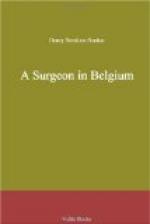With surgery on rather bold lines it was extraordinary how much could be done, especially in the way of saving limbs. During the whole of our stay in Antwerp we never once had to resort to an amputation. We were dealing with healthy and vigorous men, and once they had got over the shock of injury they had wonderful powers of recovery. We very soon found that we were dealing with cases to which the ordinary rules of surgery did not apply. The fundamental principles of the art must always be the same, but here the conditions of their application were essentially different from those of civil practice. Two of these conditions were of general interest: the great destruction of the tissues in most wounds, and the infection of the wounds, which was almost universal.
Where a wound has been produced by a large fragment of shell, one expects to see considerable damage; in fact, a whole limb may be torn off, or death may be instant from some terrible injury to the body. But where the object of the enemy is the injury of individuals, and not the destruction of buildings, they often use shrapnel, and the resulting wounds resemble those from the old smooth-bore guns of our ancestors. Shrapnel consists of a large number of bullets about half an inch in diameter packed together in a case, which carries also a charge of explosive timed to burst at the moment when it reaches its object. The balls are small and round, and if they go straight through soft tissues they do not do much damage. If, however, they strike a bone, they are so soft that their shape becomes irregular, and the injury they can produce in their further course is almost without limit. On the whole, they do not as a rule produce great damage, for in many cases they are nearly spent when they reach their mark. Pieces of the case will, of course, have much the same effect as an ordinary shell.




